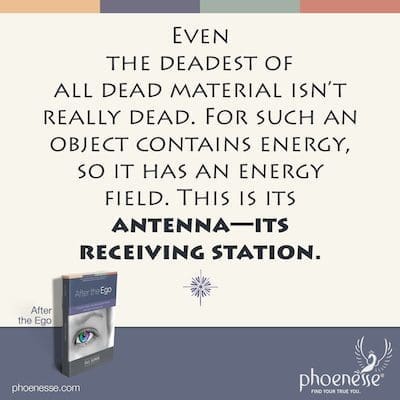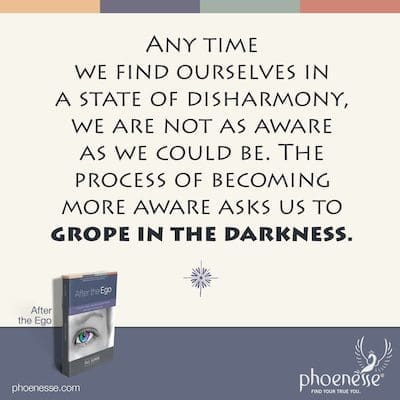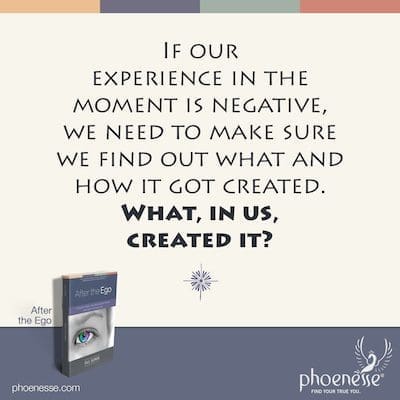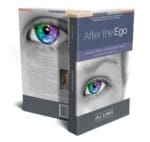In this dualistic dimension, we speak of states of consciousness and energy as though they are two distinct things. But this is not correct. To start with, it’s important to realize that consciousness permeates everything in all of creation. So all energy contains some variety and degree of consciousness. That said, consciousness is what creates energy. In fact, the energy of direct consciousness—the energy of our thoughts, feelings, intentions, attitudes and beliefs—eclipses, by far, any other kind of energy, whether electrical, physical, biological or atomic.
Each thought then is energy, and our experience of this energy is what we call a feeling. So there can be no thought—not even the most sterile, cut-off thought—that doesn’t also contain a feeling. We can imagine that a very pure, abstract thought might be completely divorced from any feeling content, but this is not the case. In reality, it’s just the opposite. The more pure and abstract a thought is, the more feeling must be attached to it.

Actually, we need to parse the difference between an abstract thought and one that is cut off. We need to not confuse the two. An abstract thought comes from a spiritual state that is highly integrated. A cut-off thought is a defense against feelings and parts of the self we think are undesirable.
But even the most cut off thought can never be totally devoid of feeling, or energetic content. Beneath the surface there may be a feeling of fear or apprehension—some sort of anxiety about something the person hopes to avoid. And when such feelings are present, self-hate is usually also part of the package.
Below the surface of a purely abstract thought there will be an energy current—a feeling—of utter peace. This comes from the inherent understanding of spiritual laws that connect to the thought, and are therefore sure to produce joy. A more subjective thought is less pure. So the more subjective a thought is, the more it will contain negative feelings.
What exactly is a subjective thought? It is a thought that comes from our personal desires and personal fears. It comes from our ego, the separated state that believes it is me versus the other. Such a thought, then, is not in truth.
Let’s examine, for example, desires. In this land of duality, desire—like everything—plays two roles. To use a paradox, we could say that from a spiritual point of view, desire is “undesirable.” After all, a desire that is too intense—a desire emanating from our ego and its distortions—alienates us from our core. This kind of desire contains pride, self-will and fear, and lacks trust in the universe. Too much desire, in this sense, contracts our energy system, creating tension and preventing the flow of the life force.
This is why spiritual teachings often advise desirelessness as the necessary condition for connecting with divine self. This state is then cherished for realizing our spiritual self.
It is, however, equally true that if we have no desire, we cannot expand. It’s not possible to venture into new spiritual lands—into new states of awareness—without desire. If there is no desire, there can be no purification. For what would motivate us to persevere and muster the courage needed to grope in the dark long enough to find our way out of our suffering? Only desire can do this. This kind of desire holds faith in the possibility we can attain the courage, patience and commitment needed to reach a better state.
This is an example of the kind of dualistic confusion we create by saying it’s either right or wrong to have desire. For it really depends on which kind of desire we are speaking of. If we hope to transcend the limited dualistic state of consciousness that is trapped in painful, confusing thinking, we will need to see beyond this kind of either/or situation. We will need to train our eyes to see both the truth and the distortion that exists on both sides.
The moment we can see this, opposites will no longer exist. And in that instant, we pass into a deeper and wider state of consciousness. From there, we will be able to see beyond the limitations of duality. This applies to so many areas of our lives. Rarely, if ever, is something good or bad, in itself. What matters is how it manifests and what the true underlying motivations are.
In order for people to overcome hurdles, we must have a desire to do so in our heart. We must want to do away with the temptation to deceive ourselves, for this is what blocks us from discovering abstract knowledge which aligns with truth. Again, be careful to understand the words used here. We are not speaking now of abstract thinking that is mechanical, dead, cut-off, unfeeling, superficial or defensive.
How could it ever be possible for consciousness—which is our inner knowing—to ever be unfeeling? Even intellectual knowledge—which is how we might refer to unfeeling knowing—must have feelings connected with it. And although people may use such knowledge to escape from the feeling aspect of living, it still contains feeling, even we if don’t recognize these feelings.
So even if we have no awareness of it, consciousness is also always a feeling. A mechanical, cut-off, fragmented thought, then, can set off a series of energetic chain reactions in our psyche. The very choice regarding which thought to think stems from such strong movements of energy, and creates an affect. So as we started out saying, consciousness and energy must be one.
If we look at the average human being, we may find it hard to believe this is always true. But when we dig a little deeper, we see that whatever thoughts we are holding, they connect with a feeling. It bears repeating, because it is so critical we get this: cut-off, dry knowledge must always also contain feelings.
Often, fear will be the underlying feeling, while the energetic state on the surface may be boredom. Boredom is a negative energetic state. If we look more closely into the deep corners of our soul, where there is boredom, fear is somewhere nearby. Perhaps fear of the self and how we fit into the cosmos. But over time, as we become more honest with ourselves and stop acting out, we will start to better understand the relationship between ourselves and the universe.

First state: Lack of awareness
We can organize the states of consciousness into three different groups. We start out in the least developed state, which is the state of slumber. In this state, a being does not know it exists. There is no self-awareness. Animals, plants, minerals and inanimate matter are at this stage. The being may be able to move and feel and grow, and to some extent it can even think. But still, it is below the threshold of being self-aware. There are, nonetheless, built-in patterns this being must follow for creation and self-creation.
An organism beneath the state of self-awareness follows meaningful, purposeful ways that align with particular laws. So while there is a state of consciousness here, there is no self-consciousness. Let’s consider the life of a plant, which follows its own built-in plan. It’s consciousness is now slumbering, yet it has a plan that imprints it with lawful cycles by which it lives, grows, dies, reincorporates itself, rebirths itself, expresses itself, and on it goes in this same lifecycle. This does not happen by accident or by “itself.” It requires an incredibly intelligent plan that can only come about from consciousness. This can’t happen through a dead or disconnected process.
When we look at minerals, it may appear that such inanimate matter must be completely disconnected. But in fact, the consciousness of this being is just temporarily frozen. This happens when consciousness creates in a particular direction that slows the life spark down until it becomes petrified. The energy becomes condensed into such a thick crust that the underlying energy looks to be invisible to the human eye. There are some people, though, whose consciousness is so great they can perceive the highly potent energy that still lurks within, even when there appears to be no consciousness. They can also pick up on the consciousness contained in the apparently “dead” inanimate matter.
What is a being in this slumbering state essentially “saying?” It may say, “I don’t want to know who I am. I don’t want to know how I relate to the world around me”. A statement like this is a creative agent, and it has been deliberately made by a consciousness that has such an attitude. This statement results in a chain of events, that surely but gradually leads to a slowed-down, condensed state. This finally hardens and forms a “crust,” making it appear dead. This, friends, is what matter is made of. It stems from a sequence of events that creates inanimate matter based on a negative statement that goes against truth.
Nevertheless, after the hardening process has gotten rolling, consciousness is able to use matter for a positive purpose that affirms life. So a free consciousness can then “communicate” with the consciousness that is nestled within the hardened matter.
This brief explanation gives us some idea of how it could be possible that consciousness can exist even in an inanimate object. From a scientific perspective, we have figured out that energy exists within matter, so that part is not news to us. What we haven’t yet uncovered is this piece about how consciousness is also contained in matter.
We are aware that we can reach the consciousness of plants, animals and other people with our own consciousness. It’s to a lesser degree that can we reach the consciousness within inanimate objects using the more active and strong consciousness of our human mind. But matter is still malleable, and we can impress it with our human consciousness.
Since consciousness has the ability to create and invent, we can mold and shape the substances that are inside of matter. So if we need an object—like a plate, or glass, or piece of furniture, or piece of jewelry—we have a desire to have that object. Our desire molds the inanimate matter—with its energy and consciousness—which receives the direction of the stronger, more connected consciousness, and fuses with it in a certain way. This is the process that creates an object.
So each object we use and enjoy is fulfilling its task. Even in this “deadened” state, the nucleus of this consciousness is seeking to express its divinity through its loving, truthful service. Even in this separated state, it is moving toward being by “replying” to the creative consciousness. As such, it is fulfilling its purpose in the great plan of evolution.
In the end, even the deadest of all dead material isn’t really dead. For such an object contains energy, so it has an energy field. This is its antenna—its receiving station. This is what it uses to react, since its consciousness is still too limited for it to be more than a reactor. It can’t initiate anything at this stage, so it can’t create the way a human can. But it is most definitely a reactor.
Perhaps we find that we have a certain close relationship with certain objects. We cherish them, need them, and enjoy them. They do well for us. We might even think we love them because they perform so well for us. They give us good service, or joy, or beauty. This is a harmless, benign circle at work in which it’s hard to say who even got the thing going.
Think of a car we like, for example, or an instrument we use. Whatever it is, we love this thing! We may even use it in support of our spiritual growth somehow. So then a purely utilitarian object isn’t really so utilitarian after all. We care for this machine or item. And our appreciation makes it respond, even though that is all it can do. With its small, limited consciousness, it is only geared to react and respond, to be molded and impressed. But our appreciation affects its energy field.
There are other objects where it’s the other way around—they never work out well. We are annoyed by them and therefore hate them, and they respond accordingly. Although we experience a separation of consciousness from them, this is debatable. The whole universe, after all, is permeated with consciousness. The separation then between objects and entities is only true on the surface. Below the surface, there is constant interaction happening.
In summary, the first state is consciousness without self-awareness, which includes animals, plants, minerals and inanimate matter. All contain consciousness and have processes for growth and change, although it happens more slowly at this stage of the game.

Second state: Self-awareness
In the second state, there is self-awareness. This is where humans are at. What do we mean by self-awareness? It means we are capable of thoughts such as, “I am,” “I think,” “I am able to make a decision,” “What I think has an effect,” and “I can reach other beings with my feelings.” This second state is the starting point for self-responsibility.
Being aware that we can affect the world around ourselves makes us accountable for our attitudes and the way we think, act and respond. We can choose these things, and we must take this responsibility seriously. Due to the fact that our level of awareness is now more expanded, there are more options available to us than before. In this state of consciousness—being above the threshold of self-awareness—we can make choices. Beings in the prior state have a pattern implanted in their soul substance they blindly follow. In the human state, we can re-create the plan. In doing so, we avail ourselves of wider possibilities for expressing ourselves that are in line with our level of development.
It’s clear that within this state, there are widely-varying degrees of self-awareness. There are humans who aren’t yet aware of themselves and their power to make changes, create new things and affect others. They have a limited ability to differentiate, and an equally limited power to act on their own and to think. The concepts presented here wouldn’t make much more sense to them than to an animal. These teachings would essentially be meaningless to them.
There are other people whose consciousness is already a lot more developed. They are well aware they have the power to choose, to create, and to create an effect. They take responsibility for their choice to think one way or another, and are accountable for their decisions. To such people, these words will make sense, and they will find them to be inspiring and encouraging. In between these two categories are people of varying degrees of consciousness.
But even those in the first group, whose consciousness is least developed, are aware they exist. They realize they have needs and, up to a point, can figure out how to fill them. They are aware they can take action. Perhaps their scope is rather limited, so their power to affect others is more diminished than it would be for someone who is more well developed. But nonetheless, they are leaps and bounds ahead of an animal. And while animals may be awake enough to think, they completely lack any sort of self-consciousness.
Being a human and having some level of self-awareness lands us in a self-created dimension that includes time. So for us, a sense of past, present and future has awakened that doesn’t exist in the lower states of consciousness. As in so many areas of development, there are similarities between the highest and lowest points on the curve. In this case, most people have some sense of time.
By contrast, animals, plants, minerals and objects don’t have a sense of time. They don’t have awareness of themselves and their ability to advance themselves, and so exist in a timeless state of being. Humans, on the other hand, exist within a framework of time. So rather than existing in a state of being, we exist in a state of becoming. This is the case, even though we already possess self-awareness. As we rise up on the curve of development, we will come back to a timeless state of being, but now our consciousness will be awake.
Third state: Universal consciousness
This third and final state is the highest level of consciousness of the three states. We could call this universal consciousness, or maybe even cosmic consciousness. Such a state is beyond the state of being human. In this state, all is one. There is no more separation. In this state of consciousness, all is known: the Godself is known and the innermost self is known.
The Godself of other entities is also known in this state, as well as the truth of being. In this state, an entity lives in a state of being, but now, at this level of development, the state of being goes beyond self-awareness. It has come to a universal awareness. Another way to say this is that we see the self as being a part of all that is.
Transitioning through states
If we ponder the deeper meaning of all this, taking it into meditation, we will understand significantly more about the greater scheme of life of which we are a part. The “innocent” state of being only exists in a purity. But this purity can exist in a being who is as yet blind, unconscious, powerless and unaware, just as it exists in one who has recaptured the state of innocence through their hard work of descending and at the same time ascending to self-purification. At that point, power reunites with the eternal now in a timeless state.
As long as a soul is not yet purified, the untapped potency of their consciousness is protected by their lack of awareness. As we proceed along our path of self-development, this power increases according to our ability to be in truth—with ourselves and with others. For if we could be aware of our power to create while we still have evil intentions, we could do harm to a greater degree than we would heal. As it stands, healing is what happens when we allow negative results to become our medicine.
When we allow evil to manifest through us, it causes results that appear unjust to us. It only looks that way to us because of our limited state that is bound in time, causing us to lose track of the connections. Were we to become aware of how all the dots connect together, we would see how all negativity—which can appear to us to be very cruel and unjust—is the self-created medicine for the ultimate healing purpose of achieving purification and therefore reaching a state of bliss.
Ultimately, evil does not destroy, although it can temporarily do so within the framework just mentioned. If it was possible for consciousness to expand without the simultaneous progress of self-purification, then evil would be able to destroy the divine. So, as a built-in way to protect this from happening, negativity closes off our perceptive organs. As a result, blindness, deafness, dumbness and numbness set in. So when we are steeped in negativity, we will unavoidably have lower awareness.
The only way we can come out of this ignorant, limited state in which we are quite powerless—cut off from the center where all of life is connected—is through our consistent efforts to know ourselves, where we are right now. This must be our goal, rather than having a goal to know the universe and what goes on outside of us. That knowing will come later, almost as a freebie. But to pursue that is to pursue illusion.

Waking up
The process of coming to know ourselves happens slowly, one step at a time. It doesn’t ask us to do impossible feats. It only asks for what is possible, which is that we deal with what’s right in front of our eyes—if we are willing to make the choice to see it. Using our goodwill and best intentions, we can find out whatever we ought to know about ourselves each step of the way.
There isn’t any fraction of time in anyone’s lives when this is not possible. Any time we find ourselves in a state of disharmony, we are not as aware as we could be. The process of becoming more aware asks us to grope in the darkness. And this will require intense searching. This is, indeed, part of our task in life.
Too often, we look in the wrong direction to find answers about our current disharmony. And too often, we also resist looking because we fear something “worse” than what is actually there. If, at all times, we will gather the courage and determination to see things all the way through, we will discover this isn’t so.
Whatever disharmonious state we are in right now—a state of anxiousness, unhappiness, depression, unrest, fear, or pain—it is always a reflection that there is something we should know about ourselves, but choose—yes, we literally choose—to not know. That choice results in a potent, negative field of energy.
The steps we take on this spiritual path help us deactivate these negative energy fields by changing the consciousness they contain. Our first step is to transition from “I don’t want to know,” to an attitude that says, “I want to know.” The next step is to follow through. We can embark on this kind of discovery adventure any time we choose.
When we are just starting out on this phase of our evolutionary journey, we will need to eliminate the blind spots we have about ourselves. Otherwise the self can’t figure out answers about the self. We can’t wake up as long as we won’t look at what we are choosing. We must see what we now think, feel, need and desire. Once we have this in hand, we can turn up the power on our ability to change what is currently undesirable and destructive.
As we go along, working in this way, we will reach a period in which we will know ourselves fairly well, but we still aren’t fully aware of others. So we get lost in what they create. We are still blind to what they are doing—to the exact nature of their negativity—so we get confused and become disturbed.
If we focus in clearing ourselves further, searching for more and more honesty, we will come to a clear awareness of others and what they are up to. This will bring us peace. It will also show us the way out of tangled up conflicts with them. Along the way, we’ll start to see aspects—positive ones—about ourselves we hadn’t noticed before. Often, the only thing that can bring forward such previously ignored aspects is a crisis with others.
The first phase of this waking-up process is self-exploration. The second phase will be to expand our knowledge of others. The first and second phases typically overlap. The third phase leads us beyond the human state, into universal awareness. That is the organic path we follow when we are on this spiritual journey.
We can interpret the word knowledge in several ways. We might have gained knowledge on a purely mechanical level, but such knowledge doesn’t contain wisdom, insight or true perception. It does not leave us with a sense of wonder and awe, and it also doesn’t give us joy or peace. This is dry, cut-off knowledge.
The knowledge we gain through our spiritual growth is a different kind of knowledge. With this kind of knowledge, a sort of comprehension takes place that brings together our fragmented understanding. This deep, feeling knowledge unifies things, and indeed brings us peace and joy, excitement and awe.
A revelation fills us that resolves all disharmony. We experience in a new way, and we relate. But friends, this doesn’t happen on our first day of walking a spiritual path. It only comes much later. At first we will only experience inklings of this, and then only occasionally. When we move into a position, for instance, of helping others, it will manifest much more fully.
The more we expand, the more this kind of knowledge will fill us. As this happens—more and more, little by little—cosmic knowledge arrives from deep within. This goes beyond the personal. It’s timeless and affords us a deep awareness of the stream of life we are flowing in, along with everyone and everything else.
We will experience an indescribable peace—imbued with joy and security— and gratitude for all that exists. This is an awareness we must earn through our personal healing work. We cannot aim directly at cosmic consciousness, but it will come if we do this work. This is the last leg of our journey, reaching this state of expanded self-awareness. This is what we are cultivating when we use these spiritual tools.

The ego’s choice
This teaching is specifically designed to make us aware of how powerful our thoughts are. Given their potency, everything we decide to think, and every attitude we decide to adopt, has great potential. Our thoughts create experiences and reactions, inside and outside of us. Within us, they will either generate a new field of energy, or they will fasten an old one in place, reinforcing it. It just depends on whether it’s a new thought, or a recycled version of something old.
This can apply whether the existing energy field is constructive or destructive, real or false. When we become truly conscious of this potency, we will start to behave more responsibly and become more capable of creating. This is how we approach the state in which we know God-consciousness is in everything.
The job of the ego is to decide which way to turn. This means that, right now, in our thinking mind lies the potential to express God’s consciousness in whatever way we like. So if our experience in the moment is negative, we need to make sure we find out what and how it got created. What, in us, created it?
We each have the ability to discover the truth about how powerful our consciousness is. We can start by making the commitment right now—and of course, we will have to commit over and over again—to be in truth. In any daily concern that puzzles, confuses or disturbs us, we can look at our reactions. Our emotional reactions are always giving us a clue about where to look.
When we feel resistance to looking, we can look at the resistance. We can admit our resistance instead of glossing over it, which is so tempting to do. And in our admission, we let in some new light. In spite of our resistance, we can admit our resistance. We can also have faith in truth.
More and more, we will free ourselves from the shackles that are now keeping us confined in a state that is less than we have a right to. Liberty is our birthright, and so is joy. In every possible situation, we can continue to make the commitment to find and be in truth. In every conceivable situation, there is always a way out.
“With this message and suggestion I bless you all with deep love—the love of the universe—for all of you, my most beloved friends. Be in peace.”
–The Pathwork Guide

Next Chapter
Return to After the Ego Contents
Read Original Pathwork Lecture #217: The Phenomenon of Consciousness


